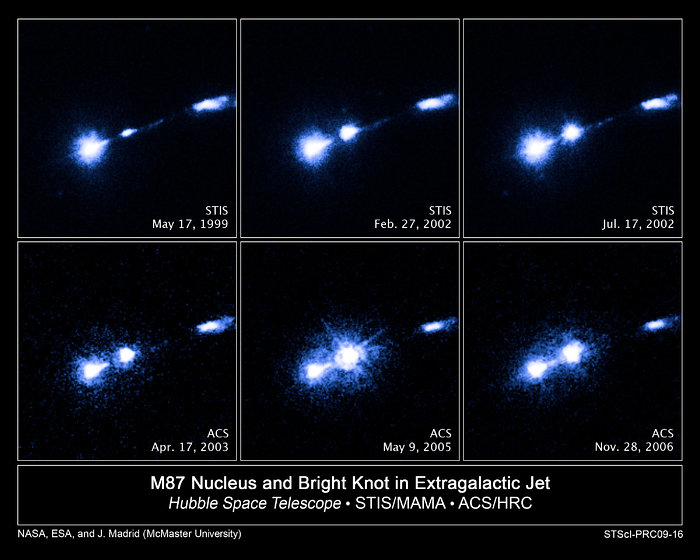Flare-up in extragalactic jet
These images taken in ultraviolet light by the NASA/ESA Hubble Space Telescope reveal the brightening of a jet of gas blasting from the core of the gigantic elliptical galaxy M87. M87 is located 54 million light-years away in the Virgo Cluster.
The flare-up is coming from a knot of hot gas, called HST-1, embedded in the jet. The jet is powered by accretion onto a supermassive black hole, one of the most massive black holes yet discovered.
Hubble's Space Telescope Imaging Spectrograph (STIS) snapped the top row of images and Hubble's Advanced Camera for Surveys (ACS) the bottom row. The core of M87 is located at lower left in the images. HST-1 is the bright blob at centre. The glowing material at far right is part of a stream of particles in the jet that speed up and glow in the ultraviolet.
The Hubble images, obtained from the Hubble archive, show the jet growing brighter over a seven-year period, eventually outshining even the luminous core of M87. The ACS image taken on 9 May 2005, reveals that HST-1 has become brighter than M87's core. HST-1 is 214 light-years from the core.
Hubble's crisp vision gives astronomers a clear view of the brightening knot. The telescope resolves HST-1 and separates it from the galaxy's core.
Credit:NASA, ESA and J. Madrid (McMaster University, Canada)
About the Image
About the Object
| Name: | M87, Messier 87, NGC 4486 |
| Type: | Local Universe : Galaxy : Type : Elliptical Local Universe : Galaxy : Component : Central Black Hole Local Universe : Galaxy : Size : Giant |
| Distance: | 55 million light years |
| Category: | Galaxies |
Colours & filters
| Band | Wavelength | Telescope |
|---|---|---|
| Ultraviolet Mid-UV | 220 nm |
Hubble Space Telescope
ACS |
| Ultraviolet Mid-UV | 250 nm |
Hubble Space Telescope
ACS |
| Ultraviolet Mid-UV | 232 nm |
Hubble Space Telescope
STIS |
